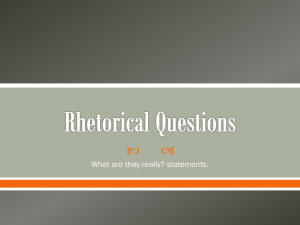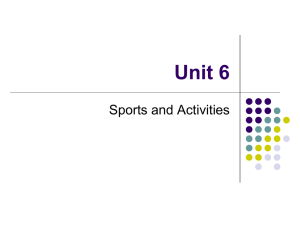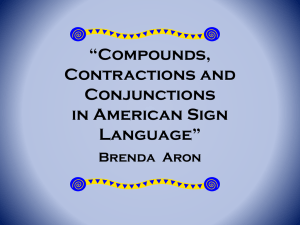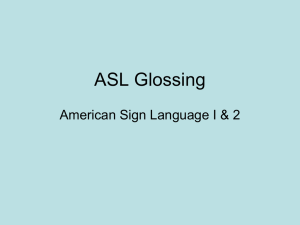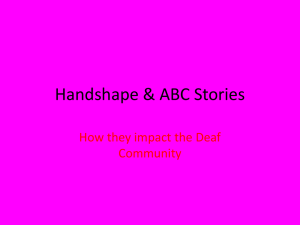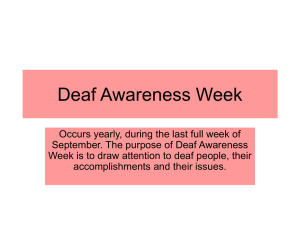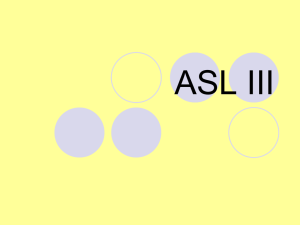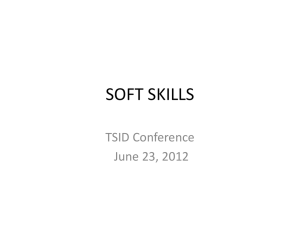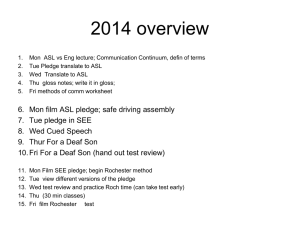Unit 6 Objectives
advertisement
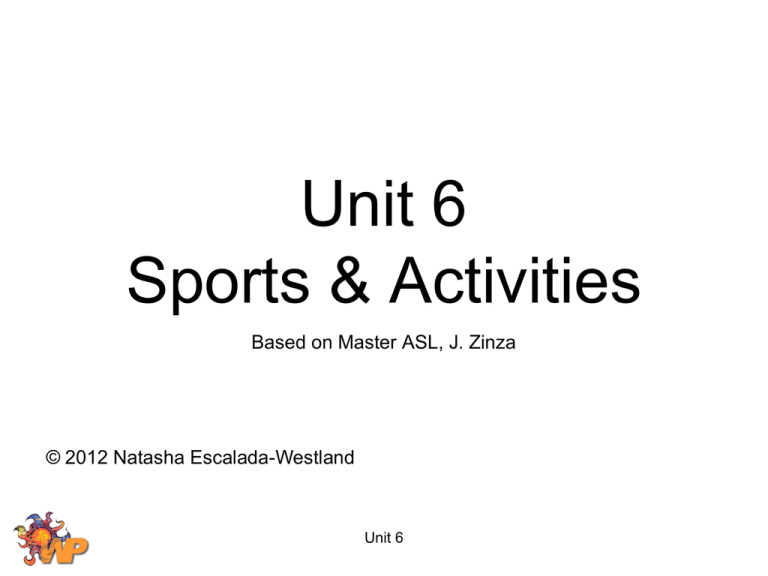
Unit 6 Sports & Activities Based on Master ASL, J. Zinza © 2012 Natasha Escalada-Westland Unit 6 Unit 6 Goals • To sign about sports • To understand the Five Parameters of ASL • To understand the different types of ASL literature • To expand classifier skills • To use the past, present, and future tenses • To understand and use the Rule of 9 Based on Master ASL Level One by Jason Zinza Unit 6 Come on Unit 6 p. 211 Involve, to be included Unit 6 p. 211 Many, a lot Unit 6 p. 211 All year, year round Unit 6 p. 213 During, in, on (time) p. 213 Use during to talk about a non-specific time when something occurs. During is used much the same way as “in” and “on” are used in English to talk abut events. Unit 6 To play Unit 6 p. 213 Team Unit 6 p. 213 Tend to, usually Unit 6 p. 213 Dialogue, MASL p. 212 1. Dialogue. Practice signing the dialogue above with a partner. 2. Analysis. Identify the following language features in the dialogue. Explain the purpose of each feature. 1. 2. 3. 4. Closing signals When signs Pronouns Non-manual signals 3. After school. Ask a partner what he or she does after school Unit 6 When do people play certain sports? Follow the example shown. People tend to bowl year round. Unit 6 Basketball Unit 6 p. 214 Baseball Unit 6 p. 214 To ride a bike Unit 6 p. 214 Bowling Unit 6 p. 214 Football Unit 6 p. 214 Golf Unit 6 p. 214 Gymnastics Unit 6 p. 214 Hockey Unit 6 p. 214 To ice skate Unit 6 p. 214 To jog Unit 6 p. 214 Karate, martial arts Unit 6 p. 214 To scuba dive Unit 6 p. 214 To snowboard Unit 6 p. 214 Soccer Unit 6 p. 214 Softball Unit 6 p. 214 To surf Unit 6 p. 214 To swim Unit 6 p. 214 Tennis Unit 6 p. 214 Volleyball (3 variations) Unit 6 p. 214 Water polo Unit 6 p. 214 Wrestling Unit 6 p. 214 Ask classmates to rate their skill with the following sports, using the signs to be good at and to be bad at. Sports 1. Are you good at ____? 2. Are you bad at ____? Baseball Gymnastics 3. Do you play ____? Are you good at it? Football Softball Swimming Volleyball 4. Do you play ____? Are you bad at it? Bowling Hockey Basketball Soccer 5. What’s your favorite sport? Unit 6 Words using during are underlined in the English sentences below. Sign each in ASL placing during in the correct location (at the beginning). The sign during is used to explain the general time an action occurs. It is a when sign, meaning it comes first in an ASL sentence. 6. During the week I practice 1. In winter they play hockey. skating. 2. When it rains, people don’t 7. People should not swim in play golf. bad weather. 3. On the weekends, I play 8. I have a volleyball practice soccer. on Thursday. 4. We learned to swim in the 9. Over the weekend we fall. take karate. 5. In nice weather I ride to 10.I work on the weekend. work. Unit 6 During summer I play baseball. You and a Deaf friend are thinking about joining a sports team. In a complete sentence, explain the time of year when people usually enjoy the following activities surfing football snowboarding gymnastics skiing softball swimming volleyball Key Signs: during, tend-to Unit 6 wrestling basketball Work with a partner to develop a dialogue using the prompt below. Your dialogue should include a greeting, at least six sentences total, a conclusion, and a farewell. easy hard 1. Make weekend plans to play or watch a sport. 2. Compare and contrast the difficulty level of two different sports. 3. Debate which sport is best to play or watch. Unit 6 Asking Have you…, MASL p. 220 ASL uses the signs to experience and finish to ask questions about whether someone has or has not done something. These types of questions often begin with “Have you…” in English, but in ASL the question is asked without using the sign have. Recall that the sign to have is literal and indicates possession of something, so using it to ask “Have you gone bowling?” is incorrect. Instead, the concept of the sign to experience asks “Do you have any experience with bowling?” Finish experience Unit 6 Not yet p. 220 Have you (experienced)? Not yet Unit 6 To bungee jump Unit 6 p. 222 To camp Unit 6 p. 222 To exercise, lift weights Unit 6 p. 222 To fish Unit 6 p. 222 To hike Unit 6 p. 222 To play cards Unit 6 p. 222 To skateboard Unit 6 p. 222 To skydive Unit 6 p. 222 What are the best conceptual matches for the English phrases below? Select from to experience, finish, and not yet. 1. I haven’t… 7. She knows how to… 2. Did you… 8. I already did… 3. He did it yesterday… 9. Not yet… 4. Have you tried… 10.Have you already tried… 5. It’s over… finish 6. I haven’t gone… 11.It’s not ready yet… 12.It’s not done yet… experience Unit 6 not yet Ask a partner whether he or she has tried the following activities. Your partner will respond following the cues provided. When done, switch roles and repeat. Question: Responses: yes No, but I have… Have you…? no Did you ever…? Unit 6 Crazy for, not crazy for (intense like or dislike), p. 221 Crazy for reflects more intensity than love it, and not crazy for is less impassioned than hate. Unit 6 Exercise I, p. 223 Discerning differences. Below are several phrases in English. Select the ASL sign from below that best shares the meaning of the English phrase. Love it Crazy for Like Not crazy for Don’t like 1. I can’t stand it… 7. She’s not my favorite person… 2. I’m not big on the idea… 8. It’s great! 3. I really like that… 9. I go nuts for… 4. I’m hooked on… 10. I don’t like it at all! 5. I like it okay… 11. I absolutely love this! 6. It’s not too bad… 12. I’m not keen on that… Unit 6 The 5 Parameters of ASL, p. 224 Each sign in ASL can be broken down and analyzed into five separate features called the Five Parameters of ASL. If one parameter is wrong, then the meaning of a sign can be drastically affected – or even disappear and leave people trying to understand what’s being signed. Signing clearly and precisely takes time and practice, and being aware of the Five Parameters can help improve your ASL skills. See how the meaning changes for each of the sign pairs when one parameter is changed. Handshape I, I am My, mine Orientation Location Movement NMS Area, place Dad, (male) Please Near (sort of) Around (time) Mom, (female) Happy Near (very) Unit 6 The Five Parameters of ASL, p. 224 (H.O.L.M. Handshape Palm Orientation Location – Use the location sign to show the general area where a sign occurs on or around the body. Unit 6 Movement Non-manual signals Includes eyebrow grammar, mouth morphemes and facial expressions for emotion. Change a sign in only one parameter to transform it into another sign. How many pairs can you think of? Handshape Orientation Location Unit 6 Movement NMS The Literature of ASL, p. 227 Both hearing and Deaf people create and enjoy literature, artistic works such as stories, poetry, riddles, and more. The literature of most cultures is written, though cultures that do not use or have a written ABC, classifier, and language also produce a specific type of literature. This handshape stories is called oral literature, meaning stories are preserved and passed down only by the act of storytelling. Until very recently, the literature produced by the Deaf culture has been primarily passed from person to person in such a way. Live or recorded storytelling has a rich tradition in the Deaf culture. Poetry, ABC stories, classifier stories, handshape rhymes, number stories, narratives, and humor form a highlyregarded body of signed, visual literature passed down from generation to generation. Unit 6 The Major Forms of Literature of ASL, p. 227 ASL poetry: Covers a broad spectrum of genres and topics, performed by a Deaf poet. Deaf poets such as Clayton Valli and Ella Mae Lentz are cherished for their poetry reflecting the shared Deaf experience. Classifier stories: Works that use only one or more specific classifiers to tell a complete, plot-driven story. Handshape rhymes: Works in which the signer tells an entire story using only one handshape, often incorporating meter, or rhythm, based on the story’s plot. ABC stories: Using only the letters of the alphabet in sequence (either A-Z or Z-A), the signer tells a complete story. ABC stories combine elements of classifier stories and handshape rhymes. Number stories: Similar to ABC stories, the signer uses specific number signs to tell a story. Number signs can be made in sequence like ABC stories (numbers 1-10, for example), in a challenging pattern (numbers 7, 5, 7, 5, for example), or in reverse order Narratives: Signed in formal ASL, narratives often relate events and aspects of the shared Deaf experience, especially humorous tales of being Deaf in a hearing world. ASL narratives often highlight Deaf history, famous Deaf persons, and Deaf accomplishments or triumphs over adversity. Unit 6 Poetry http://www.ragamala.net/transposedheads.jpg ASL/Signed The two signs differentiate between poems produced by hearing culture and those produced by Deaf performers. Over the years, Deaf poets felt the general sign poetry did not fully capture the depth of expression that is part of ASL poetry, and eventually the sign express myself / let it out became known as ASL poetry. Unit 6 p. 230 http://www.umich.edu/~isa/leisure/poetry_files/poetry.gif English/Spoken Story, to tell a story Unit 6 p. 230 Classifier, Many People, p. 225 Crowded elevator Streams of many people going somewhere. A popular penguin. Unit 6 Classifier, Animals and Seated Position, p. 228 Unit 6 To jump (animal) Unit 6 p. 229 To sit next to or show seated position, p. 229 Unit 6 CL: B & Base B, Flat Objects Unit 6 p. 228 Bug, ant - crawling Unit 6 p. 229 Ears (animal) Unit 6 p. 229 Winding road Unit 6 p. 229 Use classifiers to describe each illustration. Don’t forget to identify the person, place or thing being described by the classifier first. Unit 6 Watch “Eyes on ASL #11” again to help you understand how classifiers function. ASL Tenses: Past, Present, Future, p. 231 Eyes on ASL #13: Tense Unit 6 A Survey of ASL Tenses Karen Alkoby DePaul University School of Computer Science Chicago, IL kalkoby@shrike.depaul.edu How Do Tense Markers Work?, p. 232 yesterday now, today tomorrow Look closely at the parameter changes in the signs yesterday and tomorrow. The beginning location of each sign is on the present tense area of the ASL Timeline, but the final locations differ: Yesterday moves toward the shoulder, forming the past tense, and tomorrow moves ahead of the body, forming the future tense. Once a tense is formed, you don’t have to keep adding the same tense markers because the context is clear. However, when you change tenses you must use a new tense marker. Unit 6 The Past, p. 233 Ago, past Long time ago, distant past Before, used to Other ways to say these ideas of past in English are “a month ago,” “a week ago,” “a year ago,” or “When I was…” Remember, number can be included in many of these signs following the Rule of 9. Unit 6 Recent Past, p. 233 Recently, a little while ago Unit 6 Just, very recently Last month, p. 233 Unit 6 Last week Unit 6 p. 233 Last year Unit 6 p. 233 Exercise N, p. 233 2. Today & yesterday. Use vocabulary terms for the past to help sign each word pair. 1. I go … I went 7. Now … Before 2. They do … They used to 8. This week … Last week 3. This year … Last year 9. A month ago … A year ago 4. Very recently … Long ago 10. A week ago … A month ago 5. This month … Last month 11. Last year … Very recently 6. Today … Yesterday 12. I finished … I just finished Unit 6 Future, will, it will be Unit 6 p. 237 Distant future Unit 6 p. 237 In a few days Unit 6 p. 237 Next week Unit 6 p. 237 Next year Unit 6 p. 237 Soon (2 variations) Also means “short” or “brief” Unit 6 p. 237 Exercise R, p. 237 Concept comprehension. Provide a future tense marker (sign) that best matches each word or phrase. 1. In a while 7. Later on 2. A year from now 8. In 30 days 3. As soon as I can 9. Not in a million years! 4. A long time from now 10. In the future 5. Day after tomorrow 11. Just a few days from now 6. A week or so later 12. Some day Unit 6 Number Inclusion: Rule of 9 The Rule of 9 is a pattern at influences a concept’s duration, or how long something lasts. It is used when signing about a specific period of time or age. This period is included with the base sign, so that the difference between week and nine weeks is the incorporation of the number nine into the dominant hand. Only numbers up to 9 may be incorporated into a sign. Use the Rule of 9 with: Age Specific number of hours Specific time of day Specific number of weeks Specific number of minutes Specific number of months Specific number of days Specific amount of money Unit 6 p. 241 Number Inclusion: Rule of 9, p. 241 Example: Days Base sign: Day Duration Four days Duration Seven years old Duration Three months Example: Age Base: Age Spot Example: Months Base: Month Unit 6 Using Tense with the Rule of 9 p. 242 variations 2 weeks ago 12 weeks ago 2 days ago In 3 months Last year In 10 months Unit 6 3 days ago 2 years ago Fast, quick Unit 6 p. 240 Long (time) http://www.nasa.gov/images/content/144789main_CMB_Timeline75_lg.jpg Unit 6 p. 240 To stay Unit 6 p. 240 Exercise W, p. 241 The Rule of 9. Decide whether or not the following phrases should use the rule of 9 and provide the correct sign for each item. 1. 3 days 9. 4 hours 17. 21 days 2. 5 years old 10. 3 weeks 18. 2 minutes 3. 6 months 11. 5 minutes 19. 7 years old 4. 10 days 12. 12 hours 20. 3 hours 5. 15 minutes 13. 14 days 21. 12 weeks 6. 36 months 14. 10:00 22. 13 months 7. 1 year old 15. 45 minutes 23. 30 days 8. 5 days 16. 10 hours 24. 6:00 Unit 6 To call (a name) noun verb Unit 6 p. 236 To hear Unit 6 p. 236 To talk Unit 6 p. 236 Umpire Unit 6 p. 236 Narrative: Dummy Hoy, p. 235 Unit 6


